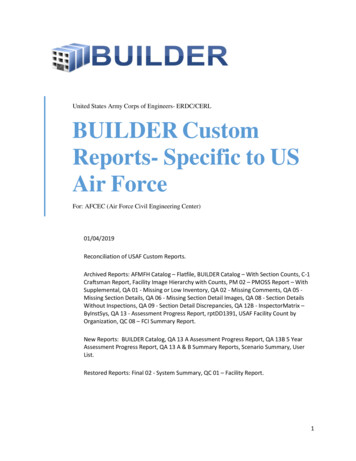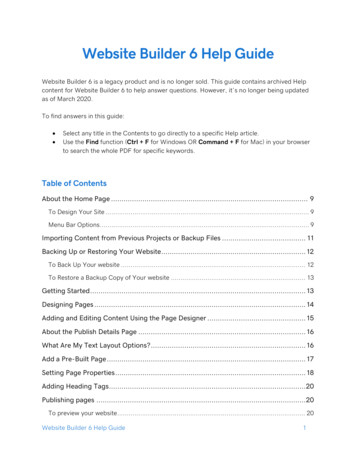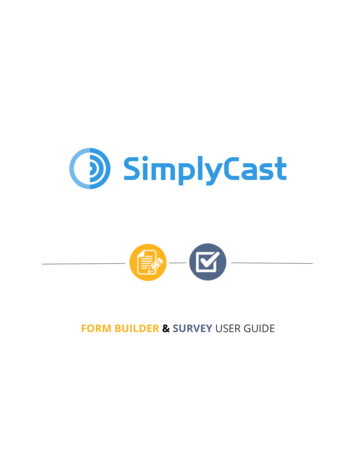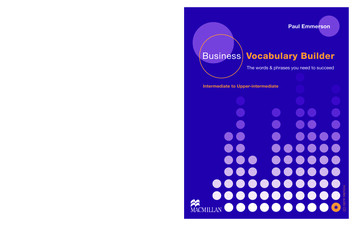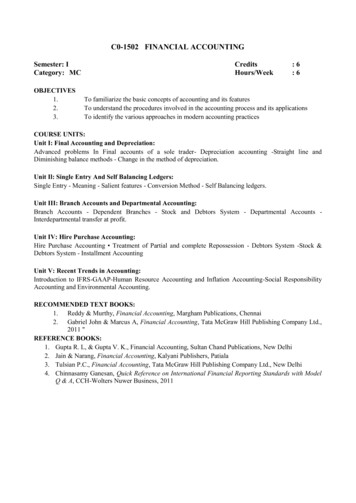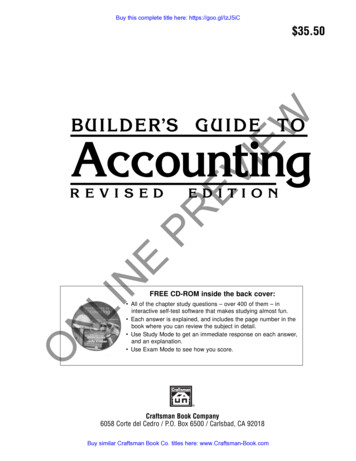
Transcription
Buy this complete title here: https://goo.gl/IzJ5iCNEPREVIEW 35.50ONLIFREE CD-ROM inside the back cover: All of the chapter study questions – over 400 of them – ininteractive self-test software that makes studying almost fun. Each answer is explained, and includes the page number in thebook where you can review the subject in detail. Use Study Mode to get an immediate response on each answer,and an explanation. Use Exam Mode to see how you score. Craftsman Book Company6058 Corte del Cedro / P.O. Box 6500 / Carlsbad, CA 92018Buy similar Craftsman Book Co. titles here: www.Craftsman-Book.com
IEWBuy this complete title here: https://goo.gl/IzJ5iCEVLooking for other construction reference manuals?PRCraftsman has the books to fill your needs. Call toll-free 1-800-829-8123or write to Craftsman Book Company, P.O. Box 6500, Carlsbad, CA 92018 fora FREE CATALOG of over 100 books, including how-to manuals,annual cost books, and estimating software.Visit our Web site: http://www.craftsman-book.comONLINEDownload all of Craftsman's most popular costbooks for one low price with theCraftsman Site License. http://www.craftsmansitelicense.comThomsett, Michael C.Builder’s guide to accounting / by Michael C. Thomsett.-- Rev. ed.p. cm.Includes index.ISBN 978-1-57218-105-21. Construction industry -- Accounting.HF5686.B7 T47 2001657’.869--dc212001047478Revised edition 2001 Craftsman Book CompanyEdited by Claudia StebelskiTenth printing 2008Buy similar Craftsman Book Co. titles here: www.Craftsman-Book.com
Buy this complete title here: https://goo.gl/IzJ5iCContents8 Planning for Profits2 Accounting Methods. . . . . . . . . . . . . . . . . . . . . . 233 Cash and Charge Sales. . . . . . . . . . . . . . . . . . . 37NERecording Cash Sales . . . . . . . . . . . . . . . . . . . 38Recording Charge Sales . . . . . . . . . . . . . . . . . 39Accounts Receivable . . . . . . . . . . . . . . . . . . . . 43Consider System Alternatives . . . . . . . . . . . . . 47Test Questions . . . . . . . . . . . . . . . . . . . . . . . . 514 Managing Receivables. . . . . . . . . . . . . . . . . . . . 53LITrack Your Receivables Trend . . . . . . . . . . . . . 53Uncollectible Accounts . . . . . . . . . . . . . . . . . . 55Receivables As a Planning Tool . . . . . . . . . . . 57Test Questions . . . . . . . . . . . . . . . . . . . . . . . . 605 Bad Debt Procedures. . . . . . . . . . . . . . . . . . . . . 63ONWhen Does an Account Become Uncollectible?. 63Journal Entries for Bad Debts . . . . . . . . . . . . . 64Estimating Bad Debts . . . . . . . . . . . . . . . . . . . 64Accounting for Bad Debts . . . . . . . . . . . . . . . 68Test Questions . . . . . . . . . . . . . . . . . . . . . . . . 696 Sales Records and Cash Budgeting. . . . . . 71Analyzing Sales Records . . . . . . . . . . . . . . . . 71Cash Flow Controls . . . . . . . . . . . . . . . . . . . . 75Test Questions . . . . . . . . . . . . . . . . . . . . . . . . 777 Sales PlanningSection TwoCosts and Expenses9 Check Writing and Recording. . . . . . . . . . . . . . . . . . . . . . . . . . . . 79Before You Take on New Kinds of Work . . . . . 79Analyze the Risk . . . . . . . . . . . . . . . . . . . . . . 80Test Questions . . . . . . . . . . . . . . . . . . . . . . . . 8495. . . . . . . . . . . . 97Maintaining the Checkbook . . . . . . . . . . . . . . 97The Check Register . . . . . . . . . . . . . . . . . . . 101Pegboard Check Registers . . . . . . . . . . . . . . . 103Other Check-Writing Methods . . . . . . . . . . . 105Paying Accounts Payable . . . . . . . . . . . . . . . 106Multiple Businesses . . . . . . . . . . . . . . . . . . . 110The Automated System . . . . . . . . . . . . . . . . . 111Test Questions . . . . . . . . . . . . . . . . . . . . . . . 113PRPercentage-of-Completion Method . . . . . . . . . 23Completed-Contract Method . . . . . . . . . . . . . . 25Which Method Should You Use? . . . . . . . . . . 25Combined Accounting Methods . . . . . . . . . . . 26Verifying the Accounts . . . . . . . . . . . . . . . . . . 28Test Questions . . . . . . . . . . . . . . . . . . . . . . . . 34W.7The Records You Need . . . . . . . . . . . . . . . . . . 8Using a Computer . . . . . . . . . . . . . . . . . . . . . 13Income Taxes . . . . . . . . . . . . . . . . . . . . . . . . . 14Forms . . . . . . . . . . . . . . . . . . . . . . . . . . . . . . . 15Double-Entry Bookkeeping . . . . . . . . . . . . . . .15Test Questions . . . . . . . . . . . . . . . . . . . . . . . . 20Analyzing the Relative Profits . . . . . . . . . . . . 88The Relationship Between Volume and Profit . 90Guidelines for Dropping Low-Profit Business . 91Test Questions . . . . . . . . . . . . . . . . . . . . . . . . 93IE1 Why Keep Records?5. . . . . . . . . . . . . . . . . . . . . . . 87EVSection OneSales and Accounts Receivable10 Accounting for Materials. . . . . . . . . . . . . . . . 115Materials Handling and Control . . . . . . . . . . 115Controlling Inventory . . . . . . . . . . . . . . . . . . 119Analyzing Materials and Inventory . . . . . . . . 121Test Questions . . . . . . . . . . . . . . . . . . . . . . . 12311 Payroll Accounting. . . . . . . . . . . . . . . . . . . . . . 125Four Ways to Keep Payroll Records . . . . . . . 126Time Cards . . . . . . . . . . . . . . . . . . . . . . . . . . 127Payroll Checks . . . . . . . . . . . . . . . . . . . . . . . 128Accounting for Tax Liabilities . . . . . . . . . . . 132Test Questions . . . . . . . . . . . . . . . . . . . . . . . 13912 Overhead Expenses. . . . . . . . . . . . . . . . . . . . . . 141Variable and Fixed Overhead . . . . . . . . . . . . 141Budgeting Expenses . . . . . . . . . . . . . . . . . . . 144General Ledger Accounts . . . . . . . . . . . . . . . 146Recording Expenses . . . . . . . . . . . . . . . . . . . 149Test Questions . . . . . . . . . . . . . . . . . . . . . . . 15213 Equipment Records. . . . . . . . . . . . . . . . . . . . . 155Classifying Fixed Assets . . . . . . . . . . . . . . . . 156Controls on Equipment Purchases . . . . . . . . . 157Depreciation . . . . . . . . . . . . . . . . . . . . . . . . . 161Depreciation Methods . . . . . . . . . . . . . . . . . . 163Amortization . . . . . . . . . . . . . . . . . . . . . . . . . 169Lease or Buy? . . . . . . . . . . . . . . . . . . . . . . . . 169Sales and Trade-Ins . . . . . . . . . . . . . . . . . . . . 170Test Questions . . . . . . . . . . . . . . . . . . . . . . . 171Buy similar Craftsman Book Co. titles here: www.Craftsman-Book.com
Buy this complete title here: https://goo.gl/IzJ5iC14 Cash Budgeting. . . . . . . . . . . . . . . . . . . . . . . . . . 173Testing the Cash Position . . . . . . . . . . . . . . . 174Preparing a Cash Budget . . . . . . . . . . . . . . . . 176Cash Control . . . . . . . . . . . . . . . . . . . . . . . . . 180Test Questions . . . . . . . . . . . . . . . . . . . . . . . 18422 Using Financial InformationApply Financial Information . . . . . . . . . . . . . 260Using Financial Information . . . . . . . . . . . . . 262Test Questions . . . . . . . . . . . . . . . . . . . . . . . 26423 Financial Ratios. . . . . 197Accounting for Direct Labor . . . . . . . . . . . . . 198Accounting for Material and Subcontracts . . 200Accounting for Overhead . . . . . . . . . . . . . . . 201Accounting for Completed-Contract Expenses. 203Test Questions . . . . . . . . . . . . . . . . . . . . . . . 20517 Petty Cash Funds. . . . . . . . . . . . . . . . . . . . . . . . 20718 Balancing the Checking Account24 Putting Together a Statement. . . . . . . 213The Ten Steps to Accurate Reconciliations . . 213Keeping Track of Your Balance . . . . . . . . . . . 219Test Questions . . . . . . . . . . . . . . . . . . . . . . . 222. . . . . . . . . . . 277Account Coding . . . . . . . . . . . . . . . . . . . . . . 277The General Ledger . . . . . . . . . . . . . . . . . . . 278The Trial Balance . . . . . . . . . . . . . . . . . . . . . 281Balance Sheet . . . . . . . . . . . . . . . . . . . . . . . . 282Income Statement . . . . . . . . . . . . . . . . . . . . . 283Closing the Books . . . . . . . . . . . . . . . . . . . . 284Test Questions . . . . . . . . . . . . . . . . . . . . . . . 28625 Comparative Period StatementPRThe Imprest System . . . . . . . . . . . . . . . . . . . 208Test Question . . . . . . . . . . . . . . . . . . . . . . . . 211W16 Accounting for Costs and ExpensesBalance Sheet Ratios . . . . . . . . . . . . . . . . . . 268Combined Ratios . . . . . . . . . . . . . . . . . . . . . 270Income Account Ratios . . . . . . . . . . . . . . . . . 272Presenting Ratios . . . . . . . . . . . . . . . . . . . . . 272Comparative Ratio Analysis . . . . . . . . . . . . . 273Test Questions . . . . . . . . . . . . . . . . . . . . . . . 274IE. . . . . . . . . . . . . . 187Objectives of the Cost System . . . . . . . . . . . 188Scheduling Costs and Expenses . . . . . . . . . . 188Control of Deferred Costs . . . . . . . . . . . . . . . 190Problems of Cost Allocation . . . . . . . . . . . . . 192Test Questions . . . . . . . . . . . . . . . . . . . . . . . 194. . . . . . . . . . . . . . . . . . . . . . . . . 267EV15 Cost and Expense Records. . . . . . . . . . . . 259. . . . . . . . . 289Comparative Balance Sheets . . . . . . . . . . . . . 289Comparative Income Statements . . . . . . . . . . 291Using Comparative Data . . . . . . . . . . . . . . . . 293Test Questions . . . . . . . . . . . . . . . . . . . . . . . 29626 Restatements by Accounting Methods. . . . . . . . . . . . . . . . 225NE19 Accounting for EstimatesLIJob Completion Schedules . . . . . . . . . . . . . . 226The Estimate . . . . . . . . . . . . . . . . . . . . . . . . . 227The Next Step — Controlling Costs . . . . . . . 230Test Questions . . . . . . . . . . . . . . . . . . . . . . . 232NSection ThreeFinancial Statements20 Recording Before the Event27 Statements by Job. . . . . . . . . . . . . . . . . . . . . . . 307Plotting Job Progress . . . . . . . . . . . . . . . . . . 308Long-Range Job Planning . . . . . . . . . . . . . . . 310Test Questions . . . . . . . . . . . . . . . . . . . . . . . 313235. . . . . . . . . . . . . 237OPercentage of Completion Adjustments . . . . . 238Accounts Receivable . . . . . . . . . . . . . . . . . . . 239Prepaid Expenses . . . . . . . . . . . . . . . . . . . . . 239Deferred Assets . . . . . . . . . . . . . . . . . . . . . . . 242Provision Accounts . . . . . . . . . . . . . . . . . . . . 243Test Questions . . . . . . . . . . . . . . . . . . . . . . . 24421 Financial Statements. . 299The Restated Income Statement . . . . . . . . . . 299Cash Accounting . . . . . . . . . . . . . . . . . . . . . . 301Test Questions . . . . . . . . . . . . . . . . . . . . . . . 304. . . . . . . . . . . . . . . . . . . . 247The Three Financial Statements . . . . . . . . . . 247The Trial Balance . . . . . . . . . . . . . . . . . . . . . 250Balance Sheet Accounts . . . . . . . . . . . . . . . . 252Income Statement Accounts . . . . . . . . . . . . . 254Statement of Cash Flows Categories . . . . . . . 255Test Questions . . . . . . . . . . . . . . . . . . . . . . . 25728 Statements for Loan Applications. . . . . . 315What Is a Loan? . . . . . . . . . . . . . . . . . . . . . . 315Loan Applications . . . . . . . . . . . . . . . . . . . . . 317Small Business Administration . . . . . . . . . . . 318Test Questions . . . . . . . . . . . . . . . . . . . . . . . 321Appendix. . . . . . . . . . . . . . . . . . . . . . . . . . . . . . . . . . . . . 323A. The Chart of Accounts . . . . . . . . . . . . . . 325B. Complete Financial Statements . . . . . . . . 329C. Expanding & Automating theAccounting System . . . . . . . . . . . . . . . . 337D. Income Tax Planning . . . . . . . . . . . . . . . . 343Answers to Test Questions . . . . . . . . . . . 347Index. . . . . . . . . . . . . . . . . . . . . . . . . . . . . . . . . . . . . . . . . 351Buy similar Craftsman Book Co. titles here: www.Craftsman-Book.com
Buy this complete title here: https://goo.gl/IzJ5iCIEWsection oneEVSales andAccounts ReceivablesPRWhy Keep Records?Accounting MethodsCash and Charge SalesNEManaging ReceivablesBad Debt ProceduresSales Records and Cash BudgetingLISales PlanningONPlanning for ProfitsBuy similar Craftsman Book Co. titles here: www.Craftsman-Book.com
ONLINEPREVIEWBuy this complete title here: https://goo.gl/IzJ5iCBuy similar Craftsman Book Co. titles here: www.Craftsman-Book.com
Buy this complete title here: https://goo.gl/IzJ5iCIEWchapter oneTEVWhy Keep Records?PRhis reference is for builders, contractors, subcontractors, and anyonein specialty trades. It’s geared to the problems builders have in maintaining a good set of useful books. Company sizes range from oneman operations all the way up to some of the world’s largest corporations.The smaller the business, the more it needs economical record keeping.NEA business operating out of a small office on a tight budget often can’tafford full-time bookkeeping and accounting services. Since the bidding isso competitive, the small operation with the lowest possible overhead willbe most likely to bid in line with larger companies, win contracts, and makea profit. Just like an outfit that wastes material and manhours, the operationthat depends too much on expensive professional services can’t competewith an efficient shop.ONLII’ll provide step-by-step suggestions for keeping books and records, andwon’t burden you with unnecessary terminology. I’ll explain the examplesin detail and use illustrations to show how to simplify the process of maintaining a good set of books. This book isn’t for accountants. It’s meant tohelp the owner or manager of a construction company save money and timeby getting involved in much of his or her own record keeping.You can use the information immediately. Without revamping yourbooks all at once, you should be able to streamline gradually and still haveall the information that you and your accountant need. And you can adaptthese suggestions to the needs of your operation. Every business is different,and no one method will work for everyone.In the beginning, you’ll probably need to spend some time developingthe ability to use your financial information to your own benefit. But in time,you’ll only need a few hours each week. You’ll be a better-rounded businessperson when you’re involved in the development of your own financialinformation.You don’t need an accounting background to keep your own in-housebooks. You do need the desire to be involved, to increase your understanding, and to cut your overhead. When you can look at a financial report anduse the information in it effectively, you’ll have added a new dimension toBuy similar Craftsman Book Co. titles here: www.Craftsman-Book.com
Buy this complete title here: https://goo.gl/IzJ5iCBuilder’s Guide to AccountingBuilders have to keep books just like other business owners. But yours must be especially completeand efficient. Today’s construction contractor is operating in a complex industry, and a good set of recordsis as necessary as any modern piece of equipment.NE The Records You NeedThe sales journal is a detailed record of all yourincome from operations. You need this detail forfinancial statements. It also provides a good way foryou to see how you’re doing compared to last year,last month, or last week.The comparison of income to past performance isvery important to you in planning. No matter whatdirection your business takes, you should have an ideaof your probable cash flow — how much cash will becoming in, and when. You can’t make informed plansunless you know your future income potential.Keeping track of sales also gives you the information you need to back up what you report for salestax (if your state levies a sales tax). Sales records arealso needed for some insurance reports, CensusBureau reports, and other forms you have to provideto various governmental agencies. For example, somestates collect a tax based on hauling and freight operations income. A sales journal breaks out this type ofsale and supports what you claim when you file areport. Verifying reported information is one important support feature of a set of books.PRYou know that when you estimate the cost of ajob, a major part of your bid is for labor. Imagine howfew contracts you’d win if your labor was twice asexpensive as everyone else’s. The same holds true fora bookkeeping method. The less time you have tospend, or pay someone else to spend, the less it willcost you to keep your books. Reducing your cost(while achieving maximum efficiency) is the goal of awell-designed bookkeeping system. If you can reachthat goal and still have the numbers you need, you’llhave a good set of books. And you’ll definitely savetime and money.SalesWNow let’s answer the question posed by the chapter title: Why Keep Records?On the other hand, a method with unneeded features will be time-consuming and expensive. Whetheryou do the work yourself or pay someone else, it’scosting you. A good method doesn’t have any fat. Thefollowing is an overview of a good accounting systemfor builders. Each component will be discussed indetail later in this guide.IEyour management skills. Then you can comfortablyleave preparing the financial statements and taxreturns to your accountant — your financial subcontractor.EV8NLIThe law requires that you keep financial records.As a result, many builders think of their bookkeepingas a necessary evil, and nothing more. But if you canmake good use of the financial information in yourbooks, you’ll be a more informed manager. The moreinsight you develop, the more effective you’llbecome. That’s why people maintained completebusiness records in the United States long before theincome tax even existed.OA set of books should tell you everything youneed to know in the least complicated way possible.The fewer papers you have to push, the better. Amethod should contain just the right amount of information — no more and no less than you really need.This guideline is one often forgotten by business people — accountants included.A method that gives you too little informationisn’t going to save you time. Sooner or later, you’llhave to go back and fill in the gaps. Imagine workingfrom a blueprint only half completed or a set of specswith missing pages. If you don’t have it all, you’rewasting your time.Good sales records are also helpful in finding theright market for your services. Because there are somany different kinds of contracting markets, youmust know which ones will let you compete mostprofitably. You must develop an understanding of thefinancial effects of providing or not providing a particular kind of service. For example, you mightassume you’re making money in one type of work.Good records will help you determine exactly howyour company is doing in that area. The result willhelp you decide which types of jobs are best for yourcompany.Sales records should provide information on specific jobs as well. There is more than one way toaccount for income. Picking the best accountingmethod to use can have a dramatic effect on yourfinancial statements and tax liability. Don’t just leavethese decisions to your accountant. When you understand reporting methods and their consequences,you’ll be able to evaluate alternatives yourself.Buy similar Craftsman Book Co. titles here: www.Craftsman-Book.com
Buy this complete title here: https://goo.gl/IzJ5iCWhy Keep Records?WLike most good sets of records, a check registershould be flexible. You can set it up to provide a foolproof method for checking the accuracy of your math.This requires listing all check amounts twice — oncein a “total” column and again in a category ofaccounts column, such as “materials” or “office supplies.” This is one case where writing somethingtwice isn’t a wasteful duplication of effort. A doublelisting gives totals for all expenses and also showsexpenses by category.PRMany builders run into their single largest bookkeeping problem when it comes to keeping track ofreceivables. It takes a lot of record keeping and a lotof time to keep up a customer ledger. Finding a goodmethod isn’t always easy. Many apparently goodideas for saving time actually result in a greater workload, while providing you with less control. It’s easyto come up with “improvements” that actually resultin duplication of effort. Not only will you waste a lotof time writing down the same information two oreven three times, but you soon lose touch with the realpurpose for the work.Good controls require timely information.Watching from month to month where you’re spending money gives you the information you need whenyou need it. Your accountant needs updated information to post your general ledger. Your analysis of budgeted and actual expenses must show a current totaleach month. The check register is essential for balancing your bank account as well.IENaturally, you need to know who owes youmoney. Your method of keeping track of receivables isimportant to the accuracy of your billings, your collections, bad debts, and financial statements.Contractors have special problems with receivablesbecause there are considerations such as retainages.You need to account for these withheld amounts separately from your normal trade receivables. AndCensus Bureau reports for many of the trades requireinformation on accounts receivable.The check register is a listing of all checks, withexpenses broken down into categories. It’s importantto write up this record each month, or even better,each week. It would be foolish to wait until the end ofthe year to construct a check register for the previoustwelve months. Considering the number of checksmost businesses write in a year, there would be nohope for any effective control this way.EVReceivables9LINEWhen you send a bill for work after the job isdone (instead of receiving cash immediately) it’sinevitable that you’ll never collect some of yourreceivables. Surprisingly, many builders are verycasual about doing work on credit. If your volumeincreases greatly over a short time, it’s important tolook at bad debt statistics critically. You might discover that the percentage of total receivables that gobad is increasing. Understanding the direction yourbad debts are going gives you two advantages: youcan budget for them and take the steps necessary totighten up on collection procedures. This couldreduce your bad debt losses.ONWhen you check historical information on receivables and bad debts, you may discover a trend. Butwithout detailed accounting information you won’thave a clear picture of the direction you’re going. Youneed more than a general familiarity with your ownbusiness affairs to make important decisions. You’vegot to have the facts, and understand the trends.ChecksKnowing where your money goes is important forcontrolling direct costs and overhead. And besidescontrolling expenses, you need to come up with agood way to analyze costs by job. Your billings, whichare based on actual spending, require 100 percentaccuracy.To collect direct cost records by job, manybuilders make copies of invoices for the job file, orrecopy the information from the check register. This isduplication of effort. Both of these methods wastetime and accumulate incomplete information. Instead,break down your check register by job to save time.Make your check register the primary control tool.The check register is also a primary source ofother important information. Your check register canbe arranged in many ways. The method you useshould fit your business. Your books and records, ifefficient and flexible, can be worth the investment youmake in them many times over.PayrollComplete payroll records show you labor costs byjob and provide information essential for unionreports and payroll tax returns. Many of these recordsare required by law. Your records, in addition to beinguseful, should be designed to meet the legal requirements. Otherwise, you’ll spend extra time goingthrough and reorganizing your records every time apayroll report is due.A necessary part of payroll bookkeeping is organization. Breaking out information by job can bedifficult if you have to start from scratch to constructBuy similar Craftsman Book Co. titles here: www.Craftsman-Book.com
Buy this complete title here: https://goo.gl/IzJ5iC10Builder’s Guide to Accountingstatement doesn’t reflect checks that haven’t cleared.Unless you balance the account, you don’t know thereal balance.Too few builders attempt to track their actuallabor costs by job. Many contractors base theirbillings on a fixed rate per hour worked by each classification of employee. This method has obviousshortcomings. A truly useful and efficient methodcomputes the actual cost at the same time the payrollis prepared and checks are made up. All payroll(except overhead payroll like the office staff) shouldbe assigned to one or more job categories. That wayyou immediately know your direct labor cost. Job categories should include not only those for large bidcontracts, but for various one-time jobs, shop, maintenance, or idle time.It doesn’t always occur to business owners tocheck the statement for bank errors. But everyoneshould do this. Banks, and their computers, are run byhumans who can and do make mistakes. It’s up to thebusiness owner (and bank customer) to discover theseerrors. Do yourself a favor, and spend a little time tocheck their work. You may be lucky and never find amistake. If that happens, stay with that bank. Youmight not know how lucky you really are!IECash on HandMost builders need a cash fund for the littleexpenses that come up from day to day: C.O.D. deliveries, postage due, coffee and donuts, a newspaper —expenses too small to write out a check for. But youmay be amazed at how much cash you can spend in amonth from a small office fund.PRDon’t depend on your bank to keep your checkbook straightened out. Balance your bank accountevery month to be sure how much cash you reallyhave. It’s not hard to balance a bank account, althoughmany builders think it is. The secret of breezingthrough a bank account is having a good money-handling method and understanding exactly how yourmethod works.You need a thorough, step-by-step procedure tofollow. I’ll outline a procedure in this guide. If youfollow all the steps completely, the bank account willbalance every time. The only way to learn is to do ityourself. Once you’re used to it, the whole procedurewill become quite routine.EVBank AccountsWa report for each different kind of information youneed. Here again, you can avoid the cumbersome andlengthy paperwork so often seen in payroll methods.LINEHaving your accountant balance your bankaccount is poor practice and an unnecessary expense.No one knows your checkbook as well as you do.After all, if you add up your own bank deposits, prepare your own checks and figure all the math, who’sbetter suited to prove the balance? And if you makeyourself responsible for this job, the side benefit isthat you’re likely to work more accurately. You won’thave to find so many mistakes at the end of the month.ONSome builders hardly ever balance their bankaccounts. That’s a dangerous omission. You may suddenly discover that you don’t have nearly as muchcash as your checkbook shows. Errors can accumulateover the months or years. By the time you discoverthe problem, it could be too late to correct it withoutembarrassment. There is no “good” time to be out offunds.You might even discover that you have more thanyou thought in your bank account. While this mightbe a nice surprise, it’s less likely, and can still have anegative effect on your business. You might miss anopportunity if you mistakenly think you don’t haveenough cash to finance it.Don’t assume that the bank statement’s endingbalance shows your true cash condition. The bankSetting up a controlled petty cash fund is the bestway to control these disbursements. In a petty cashsystem, you “vouch” for all expenses by replacingcash removed with a slip of paper (a voucher) thatexplains the reason for the expense or lists an accountnumber and gives the amount.This fund should contain enough cash to suit yourneeds. If you run out often, the fund is too small. Butkeeping too much cash around the office isn’t a goodidea. So find the smallest amount of petty cash that’sright for your business.You should be able to add all the cash and thevouchers in the cash box at any time and arrive at thedefined petty cash fund balance. You can expect occasional minor over and short problems, but a well-controlled fund will always be in balance. Documentfully all of your expenses — even the petty ones — soyou can take the full tax deduction you deserve.Equipment RecordsFew builders can operate without owning somemachinery and equipment. Depending on your specialty, you may need everything from carpentry toolsBuy similar Craftsman Book Co. titles here: www.Craftsman-Book.com
Buy this complete title here: https://goo.gl/IzJ5iCWhy Keep Records?11Following a set procedure on every bid will savetime and assure better accuracy. Use the same formula for every bid to make the entire estimate fall together smoothly. Document your costs so you have bothhistorical data and current knowledge. This is the bestway to assure yourself that the bid will yield a reasonable profit.Your records should let you calculate the hourlycost of owning and operating your equipment. Eachjob can then be charged appropriately for its share ofthe equipment cost. This is essential for determiningthe profit or loss on each of your jobs.To have this confidence in your estimating, yourbooks and records have to be organized to supply thekind of accurate information you need in a hurry. Thebest estimators use carefully prepared past costrecords to back up their conclusions.Your equipment cost will also have an effect onhow you plan for the future. Should you lease or buyheavy equipment? How much use will you get from apiece of equipment, and will that use justify theinvestment it will require? When you prepare bids onfuture contracts, you must know how m
1. Construction industry -- Accounting. HF5686.B7 T47 2001 657’.869--dc21 2001047478 Revised edition 2001 Craftsman Book Company Edited by Claudia Stebelski Tenth printing 2008 Looking for other construction reference manuals? Craftsman has the books to fill
